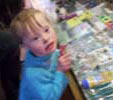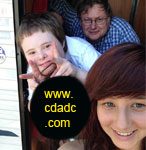

Neonatal Hypotonia
What Is Neonatal Hypotonia?
Neonatal hypotonia is defined as a lack of muscle tone apparent at or directly after birth.
It is usually caused by a genetic disorder of some kind, and while treatable, is rarely curable.
Hypotonia is defined as a problem with the central nervous system that causes the motor control nerves in the brain to be unable to communicate with the muscles as well as in a healthy person.
This lack of muscle tone has nothing to do with how strong the muscles are, but rather how quickly they can react to stimuli ranging from willful motion to reflex.
Hypotonia itself also does not impair cognitive abilities in any way. Though a person with hypotonia may have problems speaking, they do not have problems thinking clearly unless other disorders are also present.
Two types of Neonatal Hypotonia
The disorders that usually cause neonatal hypotonia generally have something to do with either the brain or the nervous system.
If some nerves of the body are injured or have lesions on them, the baby may suffer fromperipheral hypotonia.
If the problem is in the brain or spinal column, the baby has central hypotonia.
It takes a qualified physician and a series of tests to be able to tell the difference, BUT,
If the baby is lethargic, unable to track objects with their eyes, has seizures or does not attain developmental milestones on time, their hypotonia probably results from damage to the central nervous system.
If the poor muscle tone seems to be limited to one area or just on the extremities, then the child probably has peripheral hypotonia.
Disorder associated with Neonatal Hypotonia
The most common disorders carrying hypotonia as a symptom are, in order, premature birth, hypothyroidism, rickets (Vitamin D deficiency), general malnutrition, kernicterus (bilirubin poisoning), lysosomal storage diseases, and Down’s Syndrome. Note that only the last three are definitely lifelong disorders, and that many of the listed problems are preventable.
Neonatal hypotonia is not terribly common.
Remember that hypotonia is caused by a breakdown in communication between the brain and the muscles.
This breakdown can occur anywhere in the communication pathway from the brain to the spinal cord, to the peripheral nerves, at the neuromuscular junction, and even in the muscle itself.
Symptoms of Neonatal Hypotonia
Symptoms of hypotonia tend to be similar across the board.
Hypotonia is often referred to as “floppy baby syndrome” because the child feels and looks like a rag doll in your hands.
Most newborns will hold themselves rigid if held in the air by their torso alone, while a hypotonic baby will just droop.
They are not able to maintain flexed ligaments, but they are able to extend ligaments beyond normal lengths.
They also really cannot control the movements of their heads, making them even more likely to flop their heads around than a healthy newborn. It’s important to hold a hypotonic baby carefully, because they will not resist at all.
If you’re not careful, they can just slip right through your hands and arms. Never try to hold a hypotonic baby under their arms, they’ll fall right through. Instead, support them firmly with your hands on their torso.
Neonatal Hypotonia Treatment
Neonatal hypotonia often can’t be cured, especially if the underlying cause has created permanent damage or is ongoing.
However, it’s often successfully treated.
75% of children who missed developmental milestones as young toddlers go on to be almost un-noticable by adulthood.
Early intervention and treatment is absolutely vital to allow the baby as much “catch up” time as possible.
You’ll probably be working with a variety of doctors and therapists in the course of the baby’s treatment, and it’s important to follow their instructions on what to do with your child at home.
Each hypotonic baby has to be individually assessed and have a custom program of therapy designed to address that child’s specific problems.
That said, there are a few things every hypotonic baby can benefit from.
Lots of smiles, hugs, and affection both help baby to bond with you and stimulate your child’s mind and sense of body connection.
High-contrast patterns, bright primary colors, rhythmic pleasant sounds and frequent changes of environment also help.
There are quite a few newborn exercises you can use, but be sure to check with your child’s therapist to make sure the ones you pick are suitable.
Remember that neonatal hypotonia is just a symptom of an underlying problem, and those underlying problems can vary wildly in severity and impact on the child’s life.
Patience, education and lots of love are the best things you can offer to help your child.
It’s important to remember that hypotonia itself does not reduce your child’s ability to think, understand, or live a full and happy life.
By finding out all you can and entering into active partnership with your child’s medical caregivers, you can give your baby a full and rich life.
Research and main write by Loni L. Ice, quality control, editing and additional writing by D. S. Urquhart.

Leave a Reply
You must be logged in to post a comment.